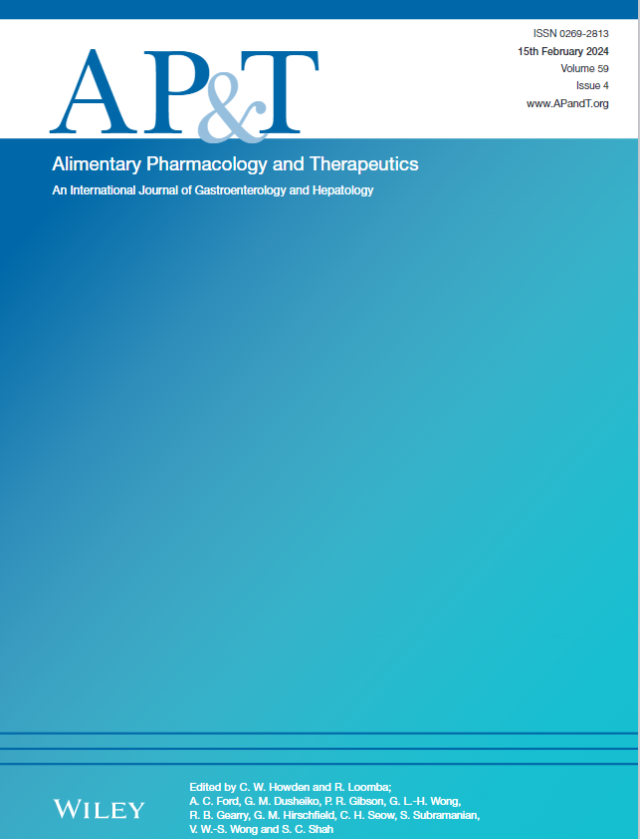使用pH值和气体感应无线运动胶囊遥测评估和比较走动健康个体的局部结肠代谢活动
IF 6.7
1区 医学
Q1 GASTROENTEROLOGY & HEPATOLOGY
引用次数: 0
摘要
可摄取的无线运动胶囊可以对人体结肠内的腔内pH值和氢和二氧化碳浓度进行局部定量。目的评价这些指标对健康成人结肠的影响。方法采用气体传感和pH传感两种无线运动胶囊,连续和反复服用。对结肠近段和远段的测量结果进行分析和比较。结果在37名参与者的配对数据集中,结肠pH值从近端中位数6.3 (IQR 5.8-6.9)上升到远端中位数7.0 (6.6-7.2)(p < 0.001)。几乎所有参与者的二氧化碳浓度都从近端12.7 (9.1-18.6)% h/h上升到远端18.8 (11.9-28.1)% h/h (p < 0.001),近端和远端结肠之间呈正相关(r = 0.76; p < 0.001)。氢浓度在近端到远端的梯度变化很大,69%的参与者增加,但近端和远端结肠测量之间没有相关性。结肠pH值、氢浓度和二氧化碳浓度之间没有明显的相关性。通过Bland-Altman分析比较串联气体传感胶囊之间的氢气和二氧化碳浓度(n = 24)显示两种测量方法的偏差极小(< 1.2%),重复摄入的气体指标相似(n = 20)。然而,远端结肠的差异更大。结论两种无线运动胶囊评价结肠发酵不同但互补的方面。二氧化碳浓度最可能反映整体微生物代谢活动的远端始终较高,而氢浓度的近端到远端梯度变化,可能是由于受试者之间饮食碳水化合物和/或甲烷生成的差异。腔内pH值较差地反映了远端结肠的碳水化合物发酵。试验注册:actrn12619001219178和ACTRN12622000422729本文章由计算机程序翻译,如有差异,请以英文原文为准。
Telemetric Assessment and Comparison of Regional Colonic Metabolic Activity in Ambulant Healthy Individuals Using pH and Gas‐Sensing Wireless Motility Capsules
BackgroundIngestible wireless motility capsules enable locoregional quantification of luminal pH and concentrations of hydrogen and carbon dioxide in the human colon.AimTo evaluate these measures in the colon of healthy adults.MethodsGas‐sensing and pH‐sensing wireless motility capsules were ingested tandemly and repeatedly over time. Measurements were analysed and compared in proximal and distal segments of the colon.ResultsIn paired datasets from 37 participants, colonic pH rose from a median 6.3 (IQR 5.8–6.9) proximally to 7.0 (6.6–7.2) distally (p < 0.001). Concentrations of carbon dioxide rose in nearly all participants from 12.7 (9.1–18.6) proximally to 18.8 (11.9–28.1) %.h/h distally (p < 0.001) with a positive correlation between proximal and distal colon (r = 0.76; p < 0.001). Hydrogen concentrations showed widely varied proximal‐to‐distal gradients with an increase in 69% of participants, but no correlation between proximal and distal colon measures. No significant correlations between colonic pH, hydrogen concentrations, and carbon dioxide concentrations were observed. Comparison of hydrogen and carbon dioxide concentrations between tandem gas‐sensing capsules by Bland–Altman analysis (n = 24) showed minimal (< 1.2%) bias for both measures, and gas metrics on repeat ingestion were similar (n = 20). However, there was greater variance in the distal colon.ConclusionsBoth wireless motility capsules evaluate different yet complementary aspects of colonic fermentation. Carbon dioxide concentrations that most likely reflect overall microbial metabolic activity were consistently greater distally, while proximal‐to‐distal gradients in hydrogen concentrations varied, likely due to inter‐subject variations in dietary carbohydrate and/or methanogenesis. Luminal pH poorly reflects carbohydrate fermentation in the distal colon.Trial RegistrationACTRN12619001219178 and ACTRN12622000422729
求助全文
通过发布文献求助,成功后即可免费获取论文全文。
去求助
来源期刊
CiteScore
15.60
自引率
7.90%
发文量
527
审稿时长
3-6 weeks
期刊介绍:
Alimentary Pharmacology & Therapeutics is a global pharmacology journal focused on the impact of drugs on the human gastrointestinal and hepato-biliary systems. It covers a diverse range of topics, often with immediate clinical relevance to its readership.

 求助内容:
求助内容: 应助结果提醒方式:
应助结果提醒方式:


